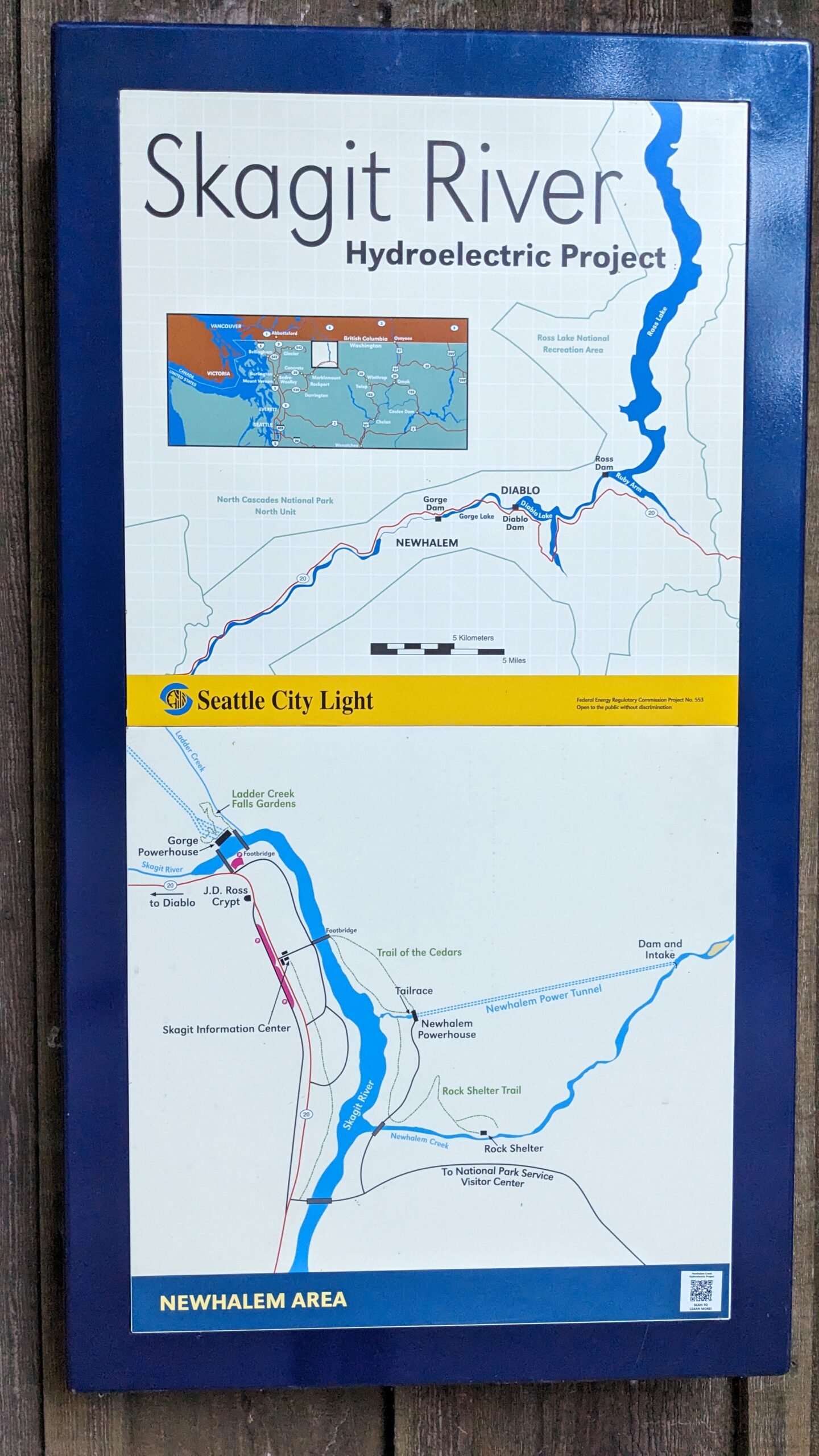The Skagit Hydroelectric Facility is a cornerstone of renewable energy production in the Pacific Northwest, providing a significant portion (up to 20%) of Seattle’s electricity. This facility, comprising Ross Dam, Diablo Dam, and Gorge Dam, represents a complex interplay of engineering ingenuity and environmental stewardship. In this post, we will explore the Skagit Hydroelectric Facility and focus on its design, technical challenges, and innovative solutions.
Overview of the Skagit Hydroelectric Facility
The Skagit Hydroelectric Project, operated by Seattle City Light, harnesses the power of the Skagit River to generate clean, renewable energy. The project includes three major dams and associated powerhouses:
- Ross Dam
- Diablo Dam
- Gorge Dam

Ross Dam
Ross Dam is the largest and most significant component of the Skagit Hydroelectric Project.
- Capacity: With a generating capacity of approximately 450 megawatts (MW), Ross Dam is a major contributor to the regional power grid.
- Construction and Design: Completed in 1952, Ross Dam is a concrete thin-arch structure. Its height of 540 feet and length of 1,300 feet make it an imposing figure on the landscape. The thin-arch design allows for efficient pressure distribution, maximizing structural integrity while minimizing material use.
- Technical Features:
- Penstocks: The dam features large penstocks that direct water from the reservoir to the turbines. These penstocks are designed to handle high-pressure water flow, optimizing energy conversion efficiency.
- Turbines and Generators: The powerhouse at Ross Dam contains Francis turbines, which are well-suited for the high head and flow conditions of the Skagit River. These turbines are coupled with synchronous generators to produce electricity.
- Control Systems: Advanced control systems manage the operation of the turbines and generators, ensuring optimal performance and grid stability.
Diablo Dam
Diablo Dam, completed in 1930, is an engineering marvel from the early 20th century.
- Capacity: This dam generates approximately 182 MW of electricity.
- Construction and Design: Diablo Dam is a gravity-arch dam, standing 389 feet tall and stretching 1,180 feet across the river. The combination of gravity and arch design elements provides robust structural support.
- Technical Features:
- Spillways: Diablo Dam features spillways designed to handle excess water flow, protecting the structure from flooding and damage. The spillways are equipped with gates that can be adjusted to regulate water release.
- Powerhouse: The powerhouse at Diablo Dam is equipped with multiple turbines and generators, each meticulously maintained to ensure efficient operation.
- Instrumentation and Monitoring: Modern instrumentation and monitoring systems track dam performance, water levels, and environmental conditions, providing real-time data for operational decisions.
Gorge Dam
Gorge Dam, the oldest of the three, was completed in 1924 and remains a vital part of the Skagit Hydroelectric Project.
- Capacity: Gorge Dam produces about 177 MW of electricity.
- Construction and Design: This arch dam is 300 feet tall and 670 feet long. Its design reflects early 20th-century engineering practices, focusing on durability and functionality.
- Technical Features:
- Water Intake Systems: The dam’s water intake systems are designed to optimize flow to the turbines, reducing turbulence and maximizing energy capture.
- Maintenance Practices: Regular maintenance and upgrades are essential to keep the aging infrastructure in top condition. This includes refurbishing turbines, replacing worn components, and updating control systems.
- Environmental Mitigation: Efforts to minimize environmental impact include fish ladders and habitat restoration projects to support local wildlife.
Engineering Challenges and Solutions
Operating a large-scale hydroelectric facility involves numerous engineering challenges. Here are some of the key issues faced by the Skagit Hydroelectric Project and the solutions implemented by electrical engineers:
Environmental Impact
- Challenge: Hydroelectric dams can disrupt local ecosystems, affecting fish populations and riverine habitats.
- Solution: Engineers have implemented fish passage facilities, such as fish ladders and bypass systems, to enable migratory species like salmon to navigate the dams. Additionally, flow regulation techniques mimic natural river conditions, supporting aquatic habitats.
Sediment Management
- Challenge: Sediment accumulation in reservoirs can reduce water storage capacity and affect turbine operation.
- Solution: Sediment management strategies include periodic dredging and the use of sediment bypass systems to maintain reservoir capacity and water quality.
Grid Integration
- Challenge: Integrating variable renewable energy sources like hydroelectric power with the electrical grid requires precise control and coordination.
- Solution: Advanced grid management technologies, including smart grid systems and automated controls, enhance grid stability and efficiency. These systems allow for real-time monitoring and adjustment of power flows, improving overall reliability.
Aging Infrastructure
- Challenge: Maintaining and upgrading aging infrastructure is essential to ensure continued reliability and safety.
- Solution: Comprehensive maintenance programs and periodic upgrades are implemented to address wear and tear. This includes refurbishing turbines, replacing outdated control systems, and reinforcing structural components.
Technological Innovations
The Skagit Hydroelectric Facility has been a testing ground for various technological innovations in the field of electrical engineering. Some notable advancements include:
- Smart Sensors and IoT: The integration of smart sensors and Internet of Things (IoT) devices enables real-time monitoring of dam conditions, water levels, and equipment performance. This data-driven approach enhances operational efficiency and predictive maintenance.
- Advanced Turbine Design: Research and development efforts focus on improving turbine efficiency and reducing environmental impact. Innovations in turbine design, such as fish-friendly turbines, aim to minimize harm to aquatic life while maximizing energy production.
- Energy Storage Solutions: The facility explores energy storage options, such as pumped hydro storage and battery systems, to enhance grid flexibility and reliability. These solutions store excess energy during periods of low demand and release it during peak usage.
- Automation and Control Systems: State-of-the-art automation and control systems manage the complex operations of the hydroelectric facility. These systems use algorithms and machine learning to optimize power generation and distribution.
Future Prospects
The future of the Skagit Hydroelectric Facility looks promising, with ongoing projects aimed at enhancing sustainability and resilience:
- Microgrids: Developing microgrids can provide localized power solutions, improving energy security and reducing transmission losses. These systems can operate independently or in conjunction with the main grid, enhancing overall reliability.
- Renewable Energy Integration: Continued integration of renewable energy sources, such as wind and solar, will diversify the energy mix and reduce carbon emissions. Hybrid systems that combine hydro, wind, and solar power can optimize resource utilization.
- Innovative Storage Technologies: Advancements in energy storage, including next-generation batteries and pumped hydro storage, will play a crucial role in balancing supply and demand. These technologies enable better management of intermittent renewable energy sources.
The Skagit Hydroelectric Facility stands as a testament to the ingenuity and dedication of electrical engineers. By addressing complex challenges and leveraging technological innovations, this facility continues to provide reliable, renewable energy while striving to minimize its environmental footprint. For electrical engineers, the Skagit Hydroelectric Facility offers a rich case study in the successful integration of engineering principles and environmental stewardship.




